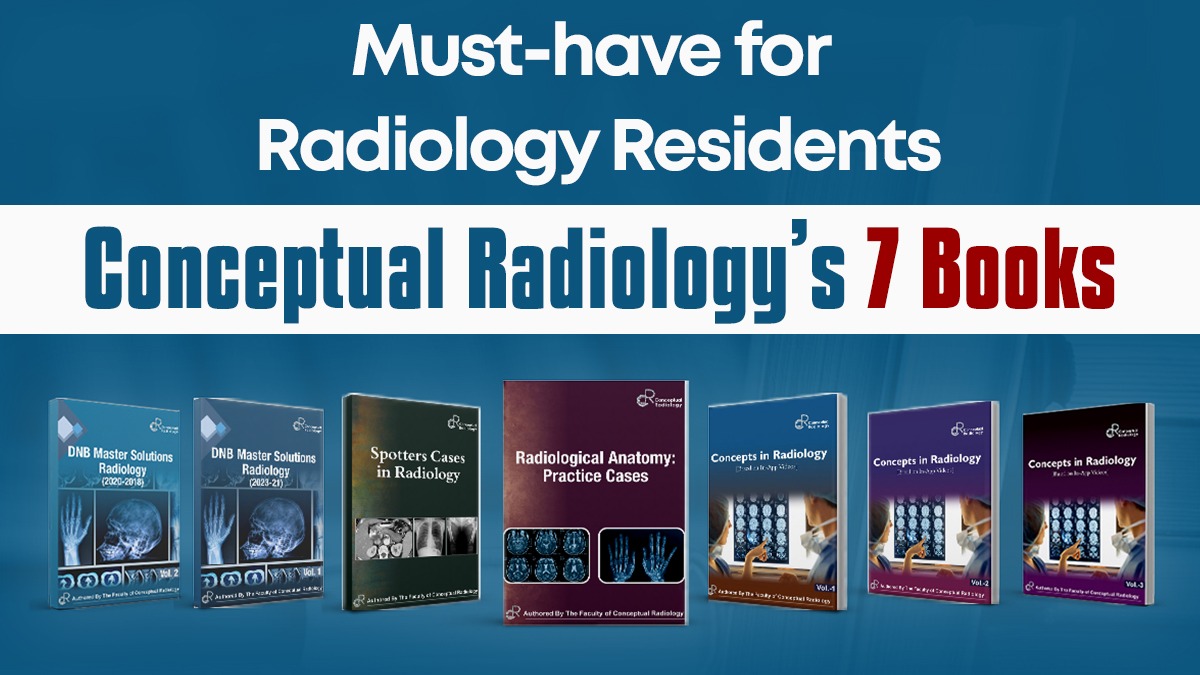Estimated reading time: 3 minutes
Radiology residency, one of the toughest medical specializations requires an excellent understanding of both knowledge of theoretical and practical aspects of imaging. Conceptual Radiology’s 7 books, curated by the expert faculty of Conceptual Radiology, are the perfect companion to help you navigate in this field.
Here’s an overview of why you need these books, and where to get your copy.
Books Overview
The Conceptual Radiology 7 Books represent a lot of knowledge regarding radiology-related topics, including foundation concepts and advanced clinical applications. Amongst the books listed in this collection are:
1. Concepts in Radiology( Vol. -1, 2 & 3 )
It is a collection of lecture notes, a comprehensive resource drawn from the collective expertise of esteemed faculty members of Conceptual Radiology, spanning various subspecialties within the field of radiology. Click here to learn about the book- Concepts in Radiology( Vol. -1, 2 & 3 )
2. Radiological Anatomy: Practice Cases
This book has been designed to bridge the gap between theoretical anatomy and its practical application through radiological imaging, ensuring that students are equipped with both the knowledge and skills necessary for clinical excellence.
Each chapter has been curated to provide a comprehensive, yet accessible review of anatomy as visualized through various imaging modalities such as X-ray, CT, MRI, and ultrasound. Click here to learn about the book- Radiological Anatomy: Practice Cases.
3. Spotters Cases in Radiology
For students, mastering radiological anatomy is essential, not only for diagnosing conditions but also for understanding how structure relates to function.
This book of Spotters Cases In Radiology by Conceptual Radiology is designed to facilitate that understanding through targeted, high-yield learning. You can directly check the sample book from here: Spotters Cases in Radiology
4. DNB Master Solutions Radiology (Vol. 1 & 2)
The book includes the actual question papers from the last six years of the DNB Radiology exams. These past papers are invaluable for understanding the trends, frequently tested topics, and the style of questions that have been set by the board. Each of these past papers is followed by comprehensive solutions, providing you with the correct answers as well as detailed explanations. To check the book click here: DNB Master Solutions Radiology
Why This Book Set Is Essential for Radiology Residency?
Knowledge in radiology residency should be acquired with practice application of that knowledge in actual situations. This book collection offers:
- Comprehensive learning: From the basic principle in radiology to sophisticated case studies in clinical, it handles every bit of information the resident needs to absorb.
- Practical Insight: The books majorly focus on connecting the dots between theoretical learning and the clinical setting, where students must develop hands-on skills useful in diagnosing or treating patients.
- Exam Preparation: With books such as DNB Master Solutions, you will be able to prepare well for national board exams by having the ability to work on actual past exam papers.
These resources have been created with a careful balance of contents, practical exercises, and visual aids that would serve to instil confidence in radiology residents about the way they approach their study.
How to Get Your Copy of the Conceptual Radiology 7 Books Series?
The conceptual Radiology 7 Books are accessible only to premium subscribers. So, to avail this precious set, visit the official site for Conceptual Radiology. These books would greatly help residents as well as radiologists to have insights throughout their academic and professional lives.
For details and to order, please visit www.conceptualradiology.com. Invest in your future as a radiologist with this resource that’s just waiting for you!


